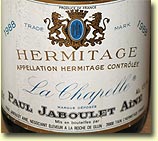 The
next course featured paired vintages (1983 and 1988) of the two
greatest Hermitage wines of the era, the Chave
rouge and the “La Chapelle” of Jaboulet. The Chave/La
Chapelle flight was clearly the FOTN; all the wines showed
superbly. I agree that the Chave's showed more intensity and
complexity, even if the La Chapelle's were generally a bit
bigger and richer. For me the 1988 Chave Find this wine was the star of
the show, perfectly mature, rich, complex and very long. The
1983 Find this wine is equally good, although showing a more rustic side,
with a bit of barnyard, but still with plenty of fruit and
vigor. The 1988 “La Chapelle” Find this wine was even bigger and
fruitier than the Chave, although less complex and without the
Chave’s elegance and breed. It would certainly be fabulous on
its own, but was upstaged by the Chave. The '83 La Chapelle
Find this wine is a controversial wine, with some bottles showing rather tannic
and dried out (I think Parker scores this wine with a ? for this
reason), but this bottle had very good fruit and balance. Again,
it lacked the depth and complexity of the Chave, but had plenty
of intensity and richness. On their own, any of these wines
would be a highlight at any meal; my favorite (by a whisker) was
the '88 Chave, with the '83 just behind.
The
next course featured paired vintages (1983 and 1988) of the two
greatest Hermitage wines of the era, the Chave
rouge and the “La Chapelle” of Jaboulet. The Chave/La
Chapelle flight was clearly the FOTN; all the wines showed
superbly. I agree that the Chave's showed more intensity and
complexity, even if the La Chapelle's were generally a bit
bigger and richer. For me the 1988 Chave Find this wine was the star of
the show, perfectly mature, rich, complex and very long. The
1983 Find this wine is equally good, although showing a more rustic side,
with a bit of barnyard, but still with plenty of fruit and
vigor. The 1988 “La Chapelle” Find this wine was even bigger and
fruitier than the Chave, although less complex and without the
Chave’s elegance and breed. It would certainly be fabulous on
its own, but was upstaged by the Chave. The '83 La Chapelle
Find this wine is a controversial wine, with some bottles showing rather tannic
and dried out (I think Parker scores this wine with a ? for this
reason), but this bottle had very good fruit and balance. Again,
it lacked the depth and complexity of the Chave, but had plenty
of intensity and richness. On their own, any of these wines
would be a highlight at any meal; my favorite (by a whisker) was
the '88 Chave, with the '83 just behind.
In the next flight (all Cote Rotie’s), the '99 Rostaing
Find this wine was the top wine and a real contender for wine of the night
(with the Chave's). Tremendous depth and richness, perfect
balance, and as the wine aired it became more and more complex.
I'd love to have a bunch of this to begin drinking in about 10
years. The 2002 Guigal La Landonne Find this wine was also terrific, and
more traditional tasting than the massive blockbuster I was
expecting. It lacked a bit of complexity compared to the
Rostaing, although it was even bigger and richer. I was less
pleased with the 1999 Guigal Ampuis, Find this wine which could have
passed for an Oz shiraz, with noticeable new oak and high
ripeness--not a style I care for, at least not in a Rhone wine.
The '97 Tardieu Laurent Find this wine wasn't a bad wine (from a
mediocre vintage, after all), but was outclassed in this group.
It showed a bit of a vegetal streak that probably would be OK if
not in such strong company.
The next flight included 3 Hermitage from the 2003 vintage, the
2003 Delas “Les Bressards”Find this wine, 2003 Marquis de Tourrette Find this wine, and
the 2003 Jaboulet “La Chappelle”Find this wine. Frankly, none of these
wines tasted like what I expect (or want) from a Northern Rhone.
As with many 2003’s that I’ve tasted, all have a pronounced
blackberry liqueur quality that tastes like someone dumped some
Chambord liqueur into the blending vat. This gave all the wines
a very monolithic quality that obliterated any differences
between them, not to mention any sense of place. Not sure if
they'll ever taste like a traditional Rhone wine, although they
seem to have good acidity and therefore could age reasonably
well. Right now, they reminded me of the Copain Arrowhead
Mountain Zinfandel, with that prominent apricot pit/blackberry
quality--for me, that flavor works better in zinfandel than in
Cote Rotie. I marginally preferred the Marquis de Tourrette, but
frankly didn’t care for any of them. The other wine in this
flight, the 2001 Guigal Ex Voto Find this wine was WOTF for me, a big
wine but with more traditional flavors and good balance.
The last flight got kind of lost for me, and was not as
interesting as what came before. The '98 Hermitage “La
Chapelle” Find this wine was disappointing, rather thin and simple. The
2000 Guigal Hermitage Find this wine was nice if not exciting, and the
2003 Delas Crozes Hermitage Find this wine was perhaps the best balanced
and most traditional wine of the flight, although it had that
streak of dullness/oafishness I find in a lot of Crozes, as
opposed to the elegance of wines from the Hermitage hill. Maybe
less favored sites avoided some of the extreme overripeness
experienced by ‘03’s from Cote Rotie and Hermitage. The
'03 Delas Cote Rotie was pretty much like the other '03's, a
freak.
Only two weeks after this dinner, another opportunity to taste
through a range of Northern Rhones presented itself. When wine
board and GrapeRadio stalwart Jay Selman posted an offline
notice to taste Cote Rotie’s on a Monday afternoon, I couldn’t
resist. So a dozen or so Orange County regulars allowed this
Long Beach (LA County) interloper to crash the party at the
office of Jay’s technology company, in the main conference room
(it is good to be boss!). Excellent eats were provided by
participant Robert Whitesell’s
catering company,
Picnic’s Deli, consisting of Canape of Grilled Lamb Loin
with sun-dried tomato pesto, feta and black olive relish;
Crostini of Smoked Duck with Dried Cherry Compote; Roasted
Mushroom Stuffed with Spinach and Bacon; and Ox Tail off the
bone braised with red wine and black trumpet mushrooms
(outstanding!), and we got to work.
The oldest wine at the tasting, the 1982 Rostaing “Cote
Blonde”, Find this wine featured a very open, fragrant nose with a bit of
bottle stink at first that quickly blew off to show
predominantly mushroom/forest floor, complex herbal note (not
green), a bit of barnyard, supple texture, completely resolved
tannins, long finish. A very complex wine that is probably a
couple of years past its peak, but is still drinking well and
should go on for a few more years yet. It rated highly with most
participants. Even better (to me) was the 1985 Dom. Bernard
Burgaud, Find this wine showing a lot more vigor and fruit, a bit of tannin
still but fully mature with very complex and long flavors and
great depth. This is just entering its peak plateau and should
drink well for many years. This got more first place votes
(including mine) than any other wine, but overall was only the
second favorite wine of the day.
The next flight moved into the mid-‘90’s , with The 1995 Dom.
Bernard Burgaud Find this wine. This was really interesting to taste after
the 1985, and the evolution of that wine could be seen in its
younger sibling. Dusty tannins, medium body but with a
tremendous depth of (not too ripe) fruit, complex herbal notes
and a long finish, this need lots of time but will be excellent.
To my taste it was much more interesting than the 1995
Chateau d’Ampuis Find this wine (Guigal) that followed, which is a big wine
that shows prominent new oak aromas and good richness, but it
seemed monolithic and a bit dull to me. Maybe it’s just going
through a dull stage, but it is clearly in a more “international
style” than the other wines tasted, which I don’t care for in
Cote Rotie. I should note that several others put this wine in
their top three wines of the day, but to me this just didn’t
have the complexity I look for in Cote Rotie and I’d put this in
the bottom half of the wines tasted. On the other hand the
1996 Chapoutier “La Mordoree”Find this wine that followed was a tremendous
wine, a “big style” wine done right. Huge body, but true,
typical Cote Rotie flavors, with excellent fruit/acid balance
and great length. This will be wonderful in another 5-10 years.
It was much better than the other Chapoutier wine in the
tasting, the 1998 Les Becasses Find this wine. Initially this was
thought to be corked, although I didn’t think so. However, it
was rather shy, in a lighter, fruitier style with medium body,
some tannins, a bit short. It seemed reasonably well balanced,
clean, but rather simple. This could be going through an awkward
phase right now (or else it was a slightly off bottle), and
although it didn’t show particularly well on this occasion, I
wouldn’t give up on it.
The next wine, the 1999 Jamet Find this wine, was a real highlight of
the day, and overall the WOTD. Very fragrant with typical
animal-tinged complex fruit/herbal notes, some tannin but in
balance with the fruit and acid; airing revealed some coffee and
chocolate notes, very long. Tremendously complex and with great
development yet to come, I’d hold on to this for at least 5, and
preferably 10 years, it will be amazing. It rather overwhelmed
the 2001 Mouton Pere & Fils Find this wine that followed. A new producer
for me, this wine showed good brightness from excellent acid and
some tannins, medium body, good berry fruit in a lighter style.
While no match for the Jamet, this would be a very nice wine on
its own with dinner.
The final Cote Rotie’s were all 2003’s, which again is a very
controversial vintage. As noted above, I am not a fan of this
vintage in the northern Rhone, as too many wines have that
pronounced blackberry liqueur flavor. Some enjoy this quality,
and that’s fine, but for me it obliterates the character of Cote
Rotie and the other Northern Rhone appellations. Typical of this
was the 2003 Delas Freres “Seigneur de Maugiron”Find this wine, which
was fumey with alcohol and blackberry notes so strong they
obliterated just about any other flavors or complexity. Even
worse was the 2003 Dom. Bernard Burgaud Find this wine, which in
addition to the blackberry/alcohol cocktail, was so tart with
screechy acidity as to be almost undrinkable. Clearly very
clumsy acidification was done here, as there is no way a wine as
ripe and alcoholic as this could be this tart with natural
acidity. The 2003 Rostaing “Cote Blonde”Find this wine wasn’t much
better; although it had less blackberry, it was clearly raisined
with a burnt charcoal/roasted quality and noticeable alcohol.
Best of the 2003’s was the Bonnefond, which had no
blackberry, and did have some of that typical animal quality and
some complexity, slightly low acid and a bit clumsy, but with
honest Cote Rotie flavors that most wines in this vintage seem
to lack.
Since the 12 Cote Rotie’s clearly weren’t enough wine to fortify
the group to face the freeways, Jay generously opened a 1966
Ch. La Mission Haut Brion Find this wine. From a bottle with a
high-shoulder fill, this wine was quite brown, with funky bacon
and mushroom notes, a bit of cigar ash, good balance, no real
fruit but not dried out, supple, and with good length. This was
sound, even enjoyable, although I suspect not the best bottle of
this wine. Too bad the oxtail was gone, because it really needed
food to show its best, but was a real treat nonetheless.
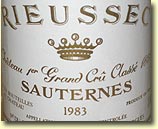 The
finale (with Mrs. Selman’s amazing apple cheesecake—WOW) were
two excellent Sauternes, starting with the wonderful 1983 Ch.
Rieussec Find this wine. Brilliant orange, tremendous depth of fruit, sweet
but not at all cloying with excellent acidity and endless
length. Lots of botrytis, orange marmalade, apple skin, very
rich. I liked it just as well as the even more intense 1990
L’Extravagant de Doise Daene Find this wine, from a tenth. Extremely sweet
and rich enough to pour on pancakes, this has TBA weight (to the
Rieussec’s BA), great power and viscosity, almost too sweet, but
retaining just enough acidity for balance. This is really too
much for any food (I’d prefer the Rieussec with foie gras), best
on its own, and a phenomenal wine.
The
finale (with Mrs. Selman’s amazing apple cheesecake—WOW) were
two excellent Sauternes, starting with the wonderful 1983 Ch.
Rieussec Find this wine. Brilliant orange, tremendous depth of fruit, sweet
but not at all cloying with excellent acidity and endless
length. Lots of botrytis, orange marmalade, apple skin, very
rich. I liked it just as well as the even more intense 1990
L’Extravagant de Doise Daene Find this wine, from a tenth. Extremely sweet
and rich enough to pour on pancakes, this has TBA weight (to the
Rieussec’s BA), great power and viscosity, almost too sweet, but
retaining just enough acidity for balance. This is really too
much for any food (I’d prefer the Rieussec with foie gras), best
on its own, and a phenomenal wine.
Bennett Traub
Reporting From The Left Coast
Send Bennett an



 Within two weeks I was able to attend two extraordinary
events: a wine dinner at the outstanding Lucques Restaurant
in West Hollywood devoted to Northern Rhone wines, and a
luncheon/tasting hosted by
Within two weeks I was able to attend two extraordinary
events: a wine dinner at the outstanding Lucques Restaurant
in West Hollywood devoted to Northern Rhone wines, and a
luncheon/tasting hosted by
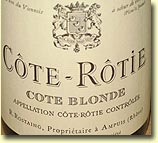 Prior
to these tastings, I got ready by drinking a couple of older
Northern Rhônes from the cellar, specifically focusing on 1983.
1983 was, at the time, considered one of the great vintages for
Northern Rhônes, but some of the wines have proven to be overly
tough and tannic, and drying out despite their obvious stuffing.
Some bottles of the (in)famous 1983 Hermitage La Chapelle have
exhibited this problem (but not all—see below!). Such also seems
to be the case with the first wine I chose, the 1983 Rostaing
Cote Rôtie “Cote Blonde”,
Prior
to these tastings, I got ready by drinking a couple of older
Northern Rhônes from the cellar, specifically focusing on 1983.
1983 was, at the time, considered one of the great vintages for
Northern Rhônes, but some of the wines have proven to be overly
tough and tannic, and drying out despite their obvious stuffing.
Some bottles of the (in)famous 1983 Hermitage La Chapelle have
exhibited this problem (but not all—see below!). Such also seems
to be the case with the first wine I chose, the 1983 Rostaing
Cote Rôtie “Cote Blonde”, 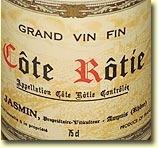 astringent, with no
fruit remaining. Extensive airing opens it up some, but this is essentially an overdry, ungenerous wine that is a bit hard to drink. Better is
the 1983 Jasmin Cote Rôtie,
astringent, with no
fruit remaining. Extensive airing opens it up some, but this is essentially an overdry, ungenerous wine that is a bit hard to drink. Better is
the 1983 Jasmin Cote Rôtie, 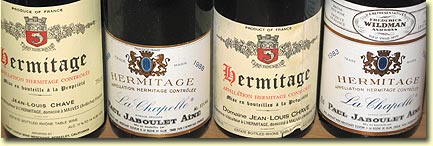
 The
next course featured paired vintages (1983 and 1988) of the two
greatest Hermitage wines of the era, the Chave
rouge and the “La Chapelle” of Jaboulet. The Chave/La
Chapelle flight was clearly the FOTN; all the wines showed
superbly. I agree that the Chave's showed more intensity and
complexity, even if the La Chapelle's were generally a bit
bigger and richer. For me the 1988 Chave
The
next course featured paired vintages (1983 and 1988) of the two
greatest Hermitage wines of the era, the Chave
rouge and the “La Chapelle” of Jaboulet. The Chave/La
Chapelle flight was clearly the FOTN; all the wines showed
superbly. I agree that the Chave's showed more intensity and
complexity, even if the La Chapelle's were generally a bit
bigger and richer. For me the 1988 Chave  The
finale (with Mrs. Selman’s amazing apple cheesecake—WOW) were
two excellent Sauternes, starting with the wonderful 1983 Ch.
Rieussec
The
finale (with Mrs. Selman’s amazing apple cheesecake—WOW) were
two excellent Sauternes, starting with the wonderful 1983 Ch.
Rieussec